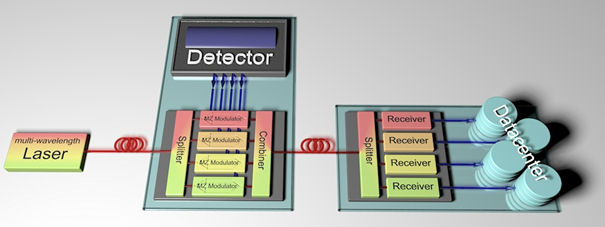
Vision
Future detectors in particle physics will comprise several million or up to a billion electrical signal channels. It is impossible to transfer all data produced to the outside with electrical wires. Here optical fibers offer a 1000 times higher bandwidth (Terabit/s), lower attenuation, lower power consumption (pJ/bit), electrical insulation, and last but not least a considerably lower mass. Extremely power efficient, elektrooptical modulators are available and should be used for data transmission. Continuous, non-modulated light will be generated outside and does not cause power dissipation inside the detector. The continuous light will be modulated inside the detector and routed to the outside to a receiver. In a further step those modulators can be integrated monolithically together with amplifiers and other electronics.
Goals and Plans
Typically digital optical data transmission is carried out by directly modulated semiconductor lasers. For this the output signals of the particle detector are digitized by a nearby ASIC and converted to an optical signal by a laser. In contrast electrooptical modulators modulate a continuous lightwave fed from the outside. With this technique power reductions of more than three orders of magnitude are possible. The intended modulators are fabricated from silicon in a CMOS compatible process and are able to transmit more than 40 Gbit/s. With more sophisticated modulation schemes and wavelength division multiplexing a multitude of such channels can be transmitted through a single glass fiber. State of the art are 325 wavelength channels with 80 Gbit/s each, which results in 26 Tbit/s, over 50 km. At this transmission bandwidth a multitude of detector channels can be digitally multiplexed to a single wavelength channel. Altogether this means a considerable reduction of data cables and possibly power feeds and cooling pipes, which results in less mass inside the detector and an increased resolution through a reduction of scattering.
But also an analog signal transmission is possible. Here the readout chip consists only of a simple circuit to adapt the detector signals to the modulator. The analog-to-digital conversion of the detector signals is performed outside of the detector. With a suitable design of the modulator the adaptation electronics could be completely omitted. The modulator would be controlled directly by the detector signals up to the point of a full optical particle detector.
The main objectives of this work package are the examination of current modulators for radiation hardness and if applicable to make them radiation hard. For an analog transmission we will examine the resolution, accuracy, noise immunity, and stability. Subsequently the modulators should be combined with ASICs, later monolithically integrated. To increase the integration density we develop and realize concepts with several modulators and associated passive optical waveguide components (e.g. wavelength division multiplexers, combiners, phase shifters, fiber couplers, …). Finally we realize a multi-channel, monolithically integrated readout chip with optical output as well as a modulator directly connected to a detector without adaptation circuitry.
Task Allocation
| FZJ | Support for optical data transmission protocol, support for and development of adaptation circuitry for analog optical transmission, development of amplifier circuitry for demonstration system. |
| GSI | Radiation hardness tests of optical and optoelectronic components, ASIC development for modulator control, design support for radiation hard components. |
| KIT | Development and fabrication of electrooptical modulators and waveguide devices, fiber chip coupling, fabrication of multi-chip modules, monolithic integration. |
Milestones
| 2013 | Radiation hardness tests of optical and optoelectronic components, development of fiber chip coupling, setup of optical data transmission demonstrator |
| 2014 | Integration of active and passive optical components, development of multi-chip module. |
| 2015 | Fabrication of multi-chip module with modulators and ASIC, analog optical transmission |



